Abstract
Heavy metals including mercury, lead, and cadmium are present throughout the ecosystem and are detectable in small amounts in the Great Lakes water and fish. The main route of exposure of humans to these metals is via the ingestion of contaminated food, especially fish. Extensive experimental investigations indicated that heavy metals alter a number of parameters of the host's immune system and lead to increased susceptibility to infections, autoimmune diseases, and allergic manifestations. The existing limited epidemiologic data and data derived from in vitro systems in which human peripheral blood leukocytes were used suggested that the human immune system may also be at increased risk following exposure to these metals. The magnitude of the risk that the presence of such metals in the Great Lakes may pose to the human immune system, and consequently to their health, is not known. In this review, the available data with respect to potential adverse effects of heavy metals on the immune system of humans and experimental animals are discussed, and additional data requirements are suggested.
Full text
PDF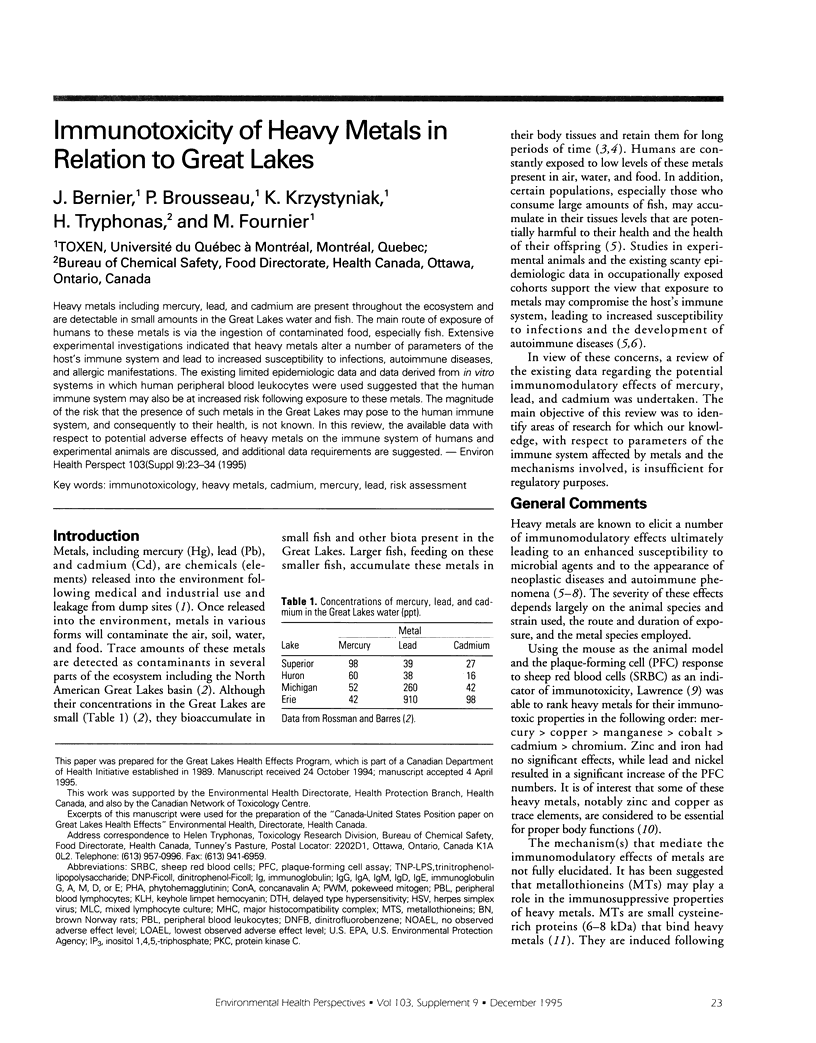
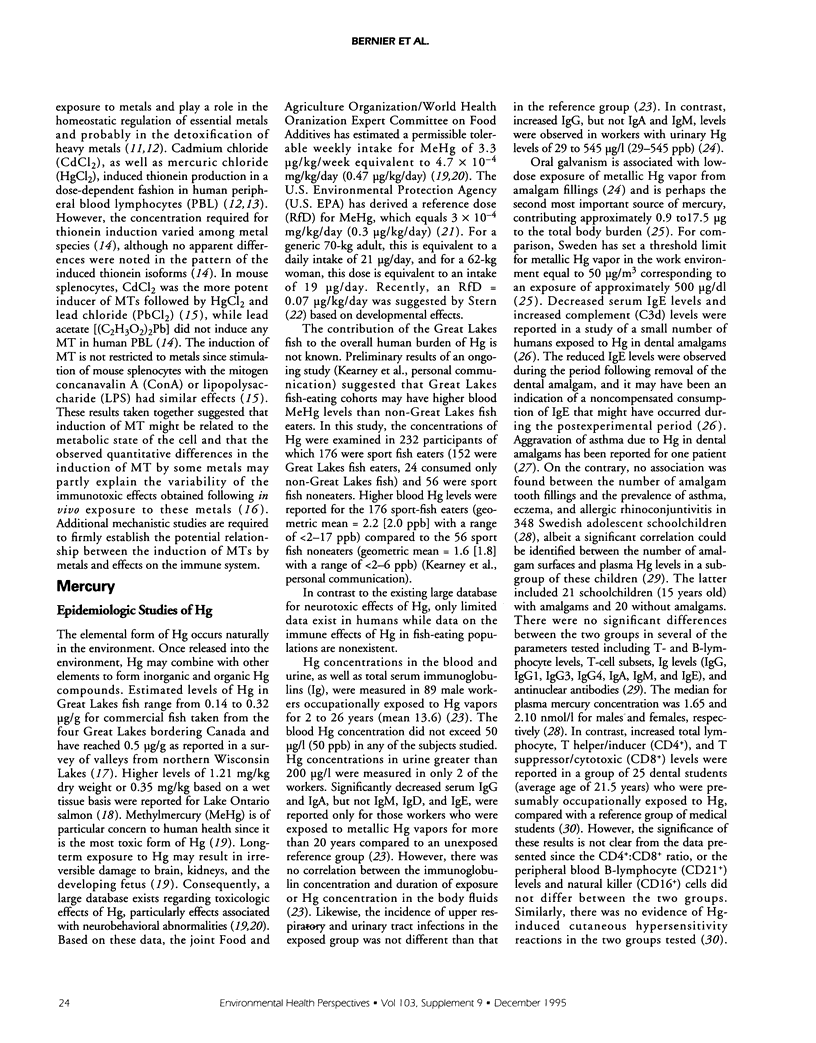
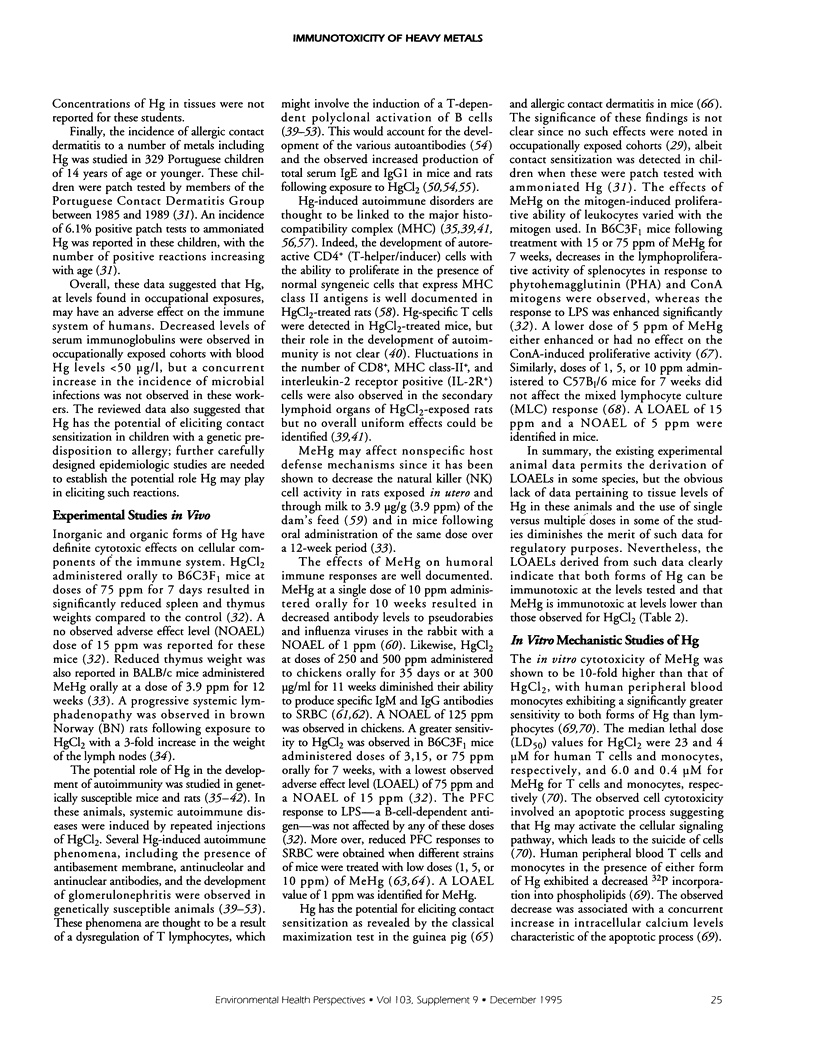
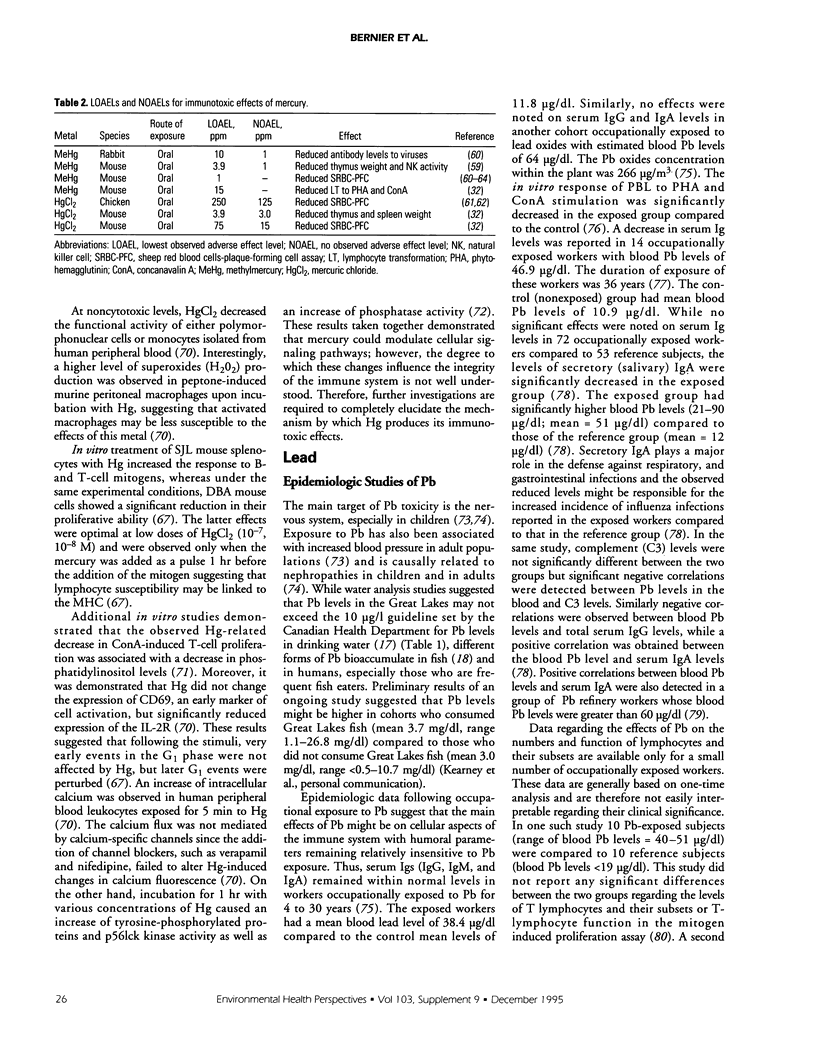
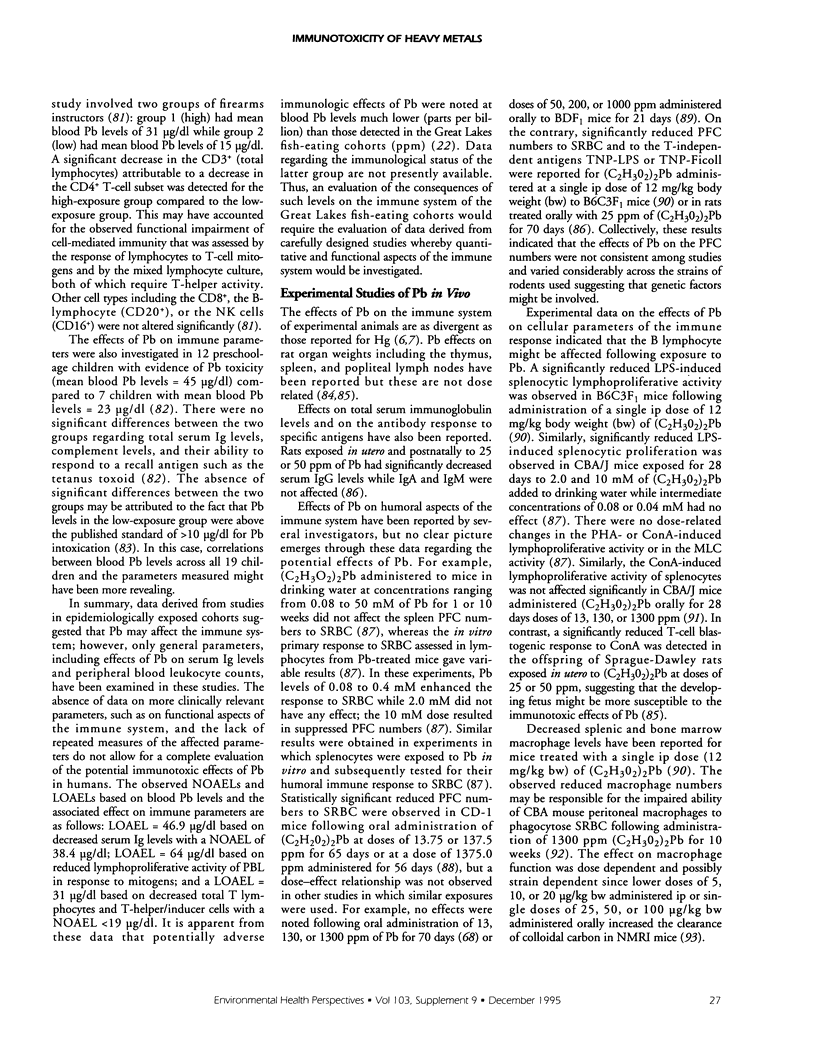
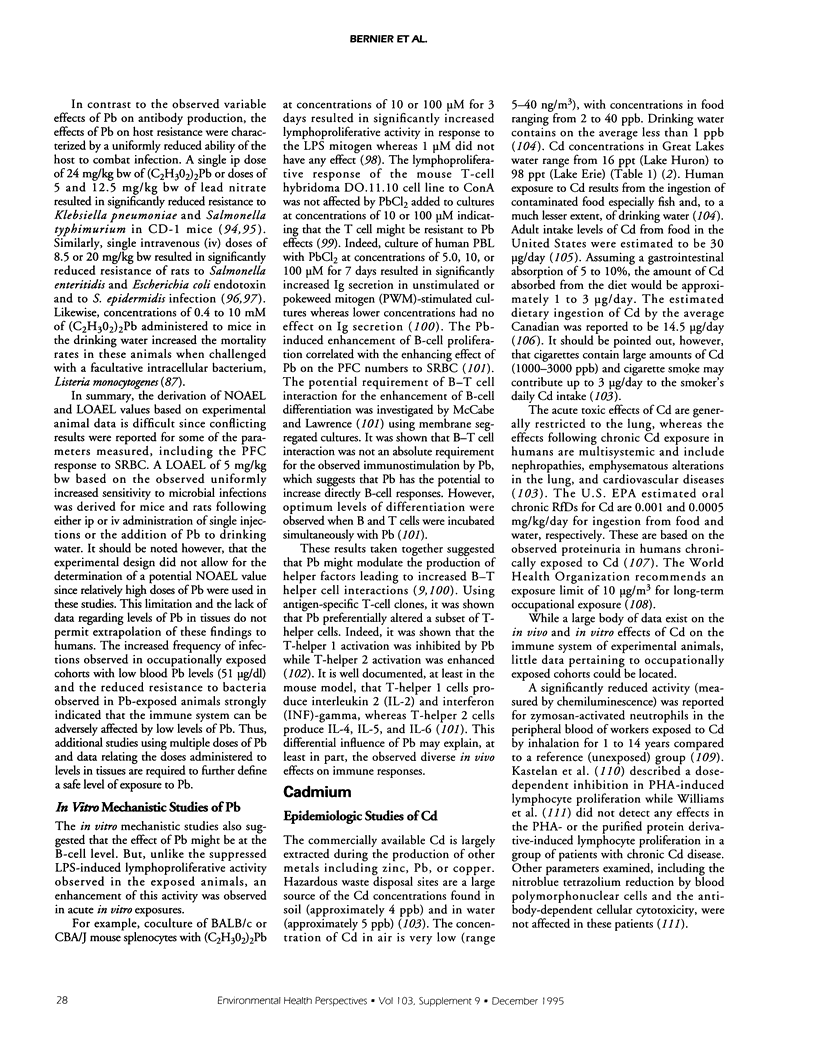

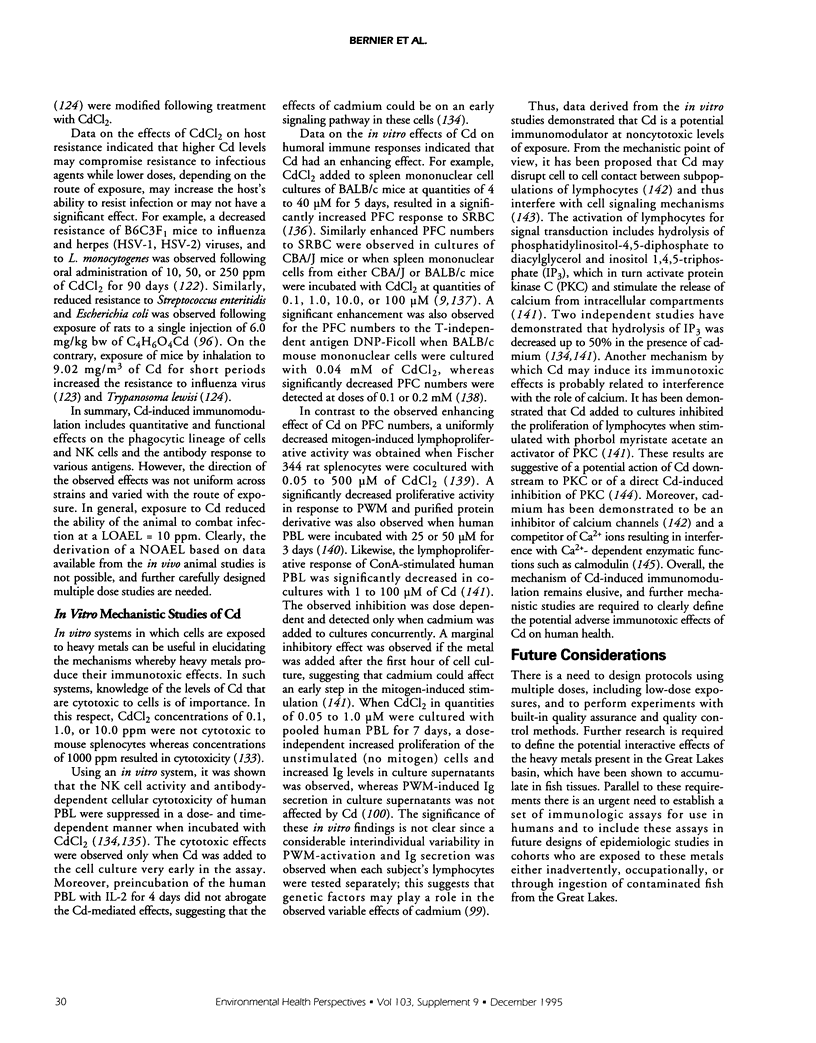


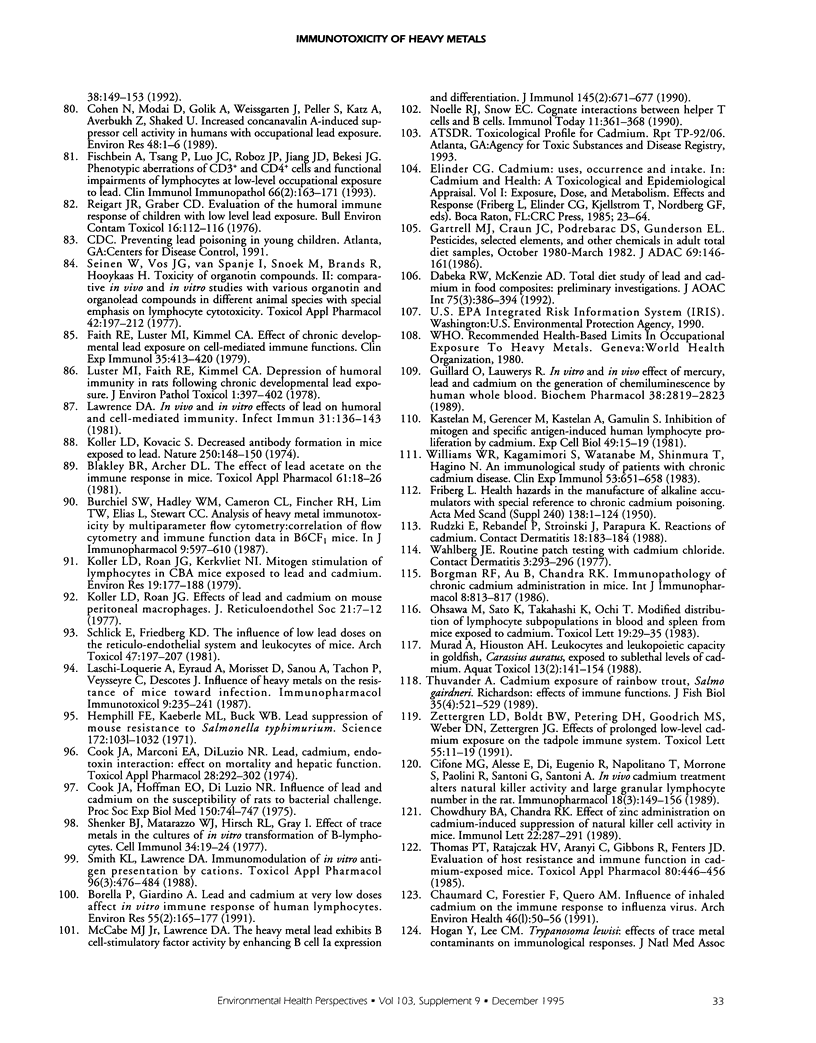

Selected References
These references are in PubMed. This may not be the complete list of references from this article.
- Anneroth G., Ericson T., Johansson I., Mörnstad H., Ryberg M., Skoglund A., Stegmayr B. Comprehensive medical examination of a group of patients with alleged adverse effects from dental amalgams. Acta Odontol Scand. 1992 Apr;50(2):101–111. doi: 10.3109/00016359209012752. [DOI] [PubMed] [Google Scholar]
- Aten J., Veninga A., Bruijn J. A., Prins F. A., de Heer E., Weening J. J. Antigenic specificities of glomerular-bound autoantibodies in membranous glomerulopathy induced by mercuric chloride. Clin Immunol Immunopathol. 1992 Apr;63(1):89–102. doi: 10.1016/0090-1229(92)90098-9. [DOI] [PubMed] [Google Scholar]
- Bencko V., Wagner V., Wagnerová M., Ondrejcák V. Immunological profiles in workers occupationally exposed to inorganic mercury. J Hyg Epidemiol Microbiol Immunol. 1990;34(1):9–15. [PubMed] [Google Scholar]
- Blakley B. R., Archer D. L. The effect of lead acetate on the immune response in mice. Toxicol Appl Pharmacol. 1981 Oct;61(1):18–26. doi: 10.1016/0041-008x(81)90003-x. [DOI] [PubMed] [Google Scholar]
- Blakley B. R., Sisodia C. S., Mukkur T. K. The effect of methylmercury, tetraethyl lead, and sodium arsenite on the humoral immune response in mice. Toxicol Appl Pharmacol. 1980 Feb;52(2):245–254. doi: 10.1016/0041-008x(80)90111-8. [DOI] [PubMed] [Google Scholar]
- Blakley B. R., Tomar R. S. The effect of cadmium on antibody responses to antigens with different cellular requirements. Int J Immunopharmacol. 1986;8(8):1009–1015. doi: 10.1016/0192-0561(86)90103-7. [DOI] [PubMed] [Google Scholar]
- Borella P., Giardino A. Lead and cadmium at very low doses affect in vitro immune response of human lymphocytes. Environ Res. 1991 Aug;55(2):165–177. doi: 10.1016/s0013-9351(05)80173-2. [DOI] [PubMed] [Google Scholar]
- Borgman R. F., Au B., Chandra R. K. Immunopathology of chronic cadmium administration in mice. Int J Immunopharmacol. 1986;8(7):813–817. doi: 10.1016/0192-0561(86)90019-6. [DOI] [PubMed] [Google Scholar]
- Bozelka B. E., Burkholder P. M. Inhibition of mixed leukocyte culture responses in cadmium-treated mice. Environ Res. 1982 Apr;27(2):421–432. doi: 10.1016/0013-9351(82)90097-4. [DOI] [PubMed] [Google Scholar]
- Bridger M. A., Thaxton J. P. Humoral immunity in the chicken as affected by mercury. Arch Environ Contam Toxicol. 1983 Jan;12(1):45–49. doi: 10.1007/BF01055000. [DOI] [PubMed] [Google Scholar]
- Burchiel S. W., Hadley W. M., Cameron C. L., Fincher R. H., Lim T. W., Elias L., Stewart C. C. Analysis of heavy metal immunotoxicity by multiparameter flow cytometry: correlation of flow cytometry and immune function data in B6CF1 mice. Int J Immunopharmacol. 1987;9(5):597–610. doi: 10.1016/0192-0561(87)90127-5. [DOI] [PubMed] [Google Scholar]
- Castillo Méndez A., Rodríguez Díaz T., León Lobeck A., Gravalosa Cruz A. J. Influencia de la exposición ocupacional al plomo sobre la concentración de inmunoglobulinas y la función celular inmune en el hombre. Rev Alerg Mex. 1991 Mar-Apr;38(2):69–72. [PubMed] [Google Scholar]
- Chaumard C., Forestier F., Quero A. M. Influence of inhaled cadmium on the immune response to influenza virus. Arch Environ Health. 1991 Jan-Feb;46(1):50–56. doi: 10.1080/00039896.1991.9937429. [DOI] [PubMed] [Google Scholar]
- Cherian M. G., Goyer R. A. Methallothioneins and their role in the metabolism and toxicity of metals. Life Sci. 1978 Jul 3;23(1):1–9. doi: 10.1016/0024-3205(78)90317-x. [DOI] [PubMed] [Google Scholar]
- Chowdhury B. A., Chandra R. K. Effect of zinc administration on cadmium-induced suppression of natural killer cell activity in mice. Immunol Lett. 1989 Oct;22(4):287–291. doi: 10.1016/0165-2478(89)90167-3. [DOI] [PubMed] [Google Scholar]
- Chávez E., Briones R., Michel B., Bravo C., Jay D. Evidence for the involvement of dithiol groups in mitochondrial calcium transport: studies with cadmium. Arch Biochem Biophys. 1985 Nov 1;242(2):493–497. doi: 10.1016/0003-9861(85)90235-8. [DOI] [PubMed] [Google Scholar]
- Cifone M. G., Alesse E., Di Eugenio R., Napolitano T., Morrone S., Paolini R., Santoni G., Santoni A. In vivo cadmium treatment alters natural killer activity and large granular lymphocyte number in the rat. Immunopharmacology. 1989 Nov-Dec;18(3):149–156. doi: 10.1016/0162-3109(89)90012-x. [DOI] [PubMed] [Google Scholar]
- Cifone M. G., Procopio A., Napolitano T., Alesse E., Santoni G., Santoni A. Cadmium inhibits spontaneous (NK), antibody-mediated (ADCC) and IL-2-stimulated cytotoxic functions of natural killer cells. Immunopharmacology. 1990 Sep-Oct;20(2):73–80. doi: 10.1016/0162-3109(90)90009-4. [DOI] [PubMed] [Google Scholar]
- Cohen N., Modai D., Golik A., Weissgarten J., Peller S., Katz A., Averbukh Z., Shaked U. Increased concanavalin A-induced suppressor cell activity in humans with occupational lead exposure. Environ Res. 1989 Feb;48(1):1–6. doi: 10.1016/s0013-9351(89)80079-9. [DOI] [PubMed] [Google Scholar]
- Cook J. A., Hoffmann E. O., Luzio NR D. i. Influence of lead and cadmium on the susceptibility of rats to bacterial challenge. Proc Soc Exp Biol Med. 1975 Dec;150(3):741–747. doi: 10.3181/00379727-150-39117. [DOI] [PubMed] [Google Scholar]
- Cook J. A., Marconi E. A., Di Luzio N. R. Lead, cadmium, endotoxin interaction: effect on mortality and hepatic function. Toxicol Appl Pharmacol. 1974 May;28(2):292–302. doi: 10.1016/0041-008x(74)90016-7. [DOI] [PubMed] [Google Scholar]
- Daum J. R., Shepherd D. M., Noelle R. J. Immunotoxicology of cadmium and mercury on B-lymphocytes--I. Effects on lymphocyte function. Int J Immunopharmacol. 1993 Apr;15(3):383–394. doi: 10.1016/0192-0561(93)90049-5. [DOI] [PubMed] [Google Scholar]
- Descotes J. Immunotoxicology of cadmium. IARC Sci Publ. 1992;(118):385–390. [PubMed] [Google Scholar]
- Dieter M. P., Luster M. I., Boorman G. A., Jameson C. W., Dean J. H., Cox J. W. Immunological and biochemical responses in mice treated with mercuric chloride. Toxicol Appl Pharmacol. 1983 Apr;68(2):218–228. doi: 10.1016/0041-008x(83)90006-6. [DOI] [PubMed] [Google Scholar]
- Drouet M., Le Sellin J., Bonneau J. C., Sabbah A. Le mercure est-il un allergène des voies respiratoires. Allerg Immunol (Paris) 1990 Mar;22(3):81, 84-8. [PubMed] [Google Scholar]
- Dubey C., Bellon B., Hirsch F., Kuhn J., Vial M. C., Goldman M., Druet P. Increased expression of class II major histocompatibility complex molecules on B cells in rats susceptible or resistant to HgCl2-induced autoimmunity. Clin Exp Immunol. 1991 Oct;86(1):118–123. doi: 10.1111/j.1365-2249.1991.tb05783.x. [DOI] [PMC free article] [PubMed] [Google Scholar]
- Eedy D. J., Burrows D., Clifford T., Fay A. Elevated T cell subpopulations in dental students. J Prosthet Dent. 1990 May;63(5):593–596. doi: 10.1016/0022-3913(90)90082-n. [DOI] [PubMed] [Google Scholar]
- Ewers U., Stiller-Winkler R., Idel H. Serum immunoglobulin, complement C3, and salivary IgA levels in lead workers. Environ Res. 1982 Dec;29(2):351–357. doi: 10.1016/0013-9351(82)90036-6. [DOI] [PubMed] [Google Scholar]
- FRIBERG L. Health hazards in the manufacture of alkaline accumulators with special reference to chronic cadmium poisoning; a clinical and experimental study. Acta Med Scand Suppl. 1950;240:1–124. [PubMed] [Google Scholar]
- Faith R. E., Luster M. I., Kimmel C. A. Effect of chronic developmental lead exposure on cell-mediated immune functions. Clin Exp Immunol. 1979 Mar;35(3):413–420. [PMC free article] [PubMed] [Google Scholar]
- Fischbein A., Tsang P., Luo J. C., Roboz J. P., Jiang J. D., Bekesi J. G. Phenotypic aberrations of CD3+ and CD4+ cells and functional impairments of lymphocytes at low-level occupational exposure to lead. Clin Immunol Immunopathol. 1993 Feb;66(2):163–168. doi: 10.1006/clin.1993.1020. [DOI] [PubMed] [Google Scholar]
- Fujimaki H. In vitro effect of cadmium on primary antibody response to T-cell independent antigen (DNP-Ficoll). Toxicol Lett. 1985 Jan;24(1):21–24. doi: 10.1016/0378-4274(85)90134-1. [DOI] [PubMed] [Google Scholar]
- Fujimaki H., Murakami M., Kubota K. In vitro evaluation of cadmium-induced augmentation of the antibody response. Toxicol Appl Pharmacol. 1982 Feb;62(2):288–293. doi: 10.1016/0041-008x(82)90127-2. [DOI] [PubMed] [Google Scholar]
- Gartrell M. J., Craun J. C., Podrebarac D. S., Gunderson E. L. Pesticides, selected elements, and other chemicals in adult total diet samples, October 1980-March 1982. J Assoc Off Anal Chem. 1986 Jan-Feb;69(1):146–159. [PubMed] [Google Scholar]
- Gonçalo S., Gonçalo M., Azenha A., Barros M. A., Bastos A. S., Brandão F. M., Faria A., Marques M. S., Pecegueiro M., Rodrigues J. B. Allergic contact dermatitis in children. A multicenter study of the Portuguese Contact Dermatitis Group (GPEDC). Contact Dermatitis. 1992 Feb;26(2):112–115. doi: 10.1111/j.1600-0536.1992.tb00894.x. [DOI] [PubMed] [Google Scholar]
- Graham J. A., Miller F. J., Daniels M. J., Payne E. A., Gardner D. E. Influence of cadmium, nickel, and chromium on primary immunity in mice. Environ Res. 1978 Jul;16(1-3):77–87. doi: 10.1016/0013-9351(78)90144-5. [DOI] [PubMed] [Google Scholar]
- Guillard O., Lauwerys R. In vitro and in vivo effect of mercury, lead and cadmium on the generation of chemiluminescence by human whole blood. Biochem Pharmacol. 1989 Sep 1;38(17):2819–2823. doi: 10.1016/0006-2952(89)90436-x. [DOI] [PubMed] [Google Scholar]
- Hemphill F. E., Kaeberle M. L., Buck W. B. Lead suppression of mouse resistance to Salmonella typhimurium. Science. 1971 Jun 4;172(3987):1031–1032. doi: 10.1126/science.172.3987.1031. [DOI] [PubMed] [Google Scholar]
- Herrström P., Holmén A., Karlsson A., Raihle G., Schütz A., Högstedt B. Immune factors, dental amalgam, and low-dose exposure to mercury in Swedish adolescents. Arch Environ Health. 1994 May-Jun;49(3):160–164. doi: 10.1080/00039896.1994.9940376. [DOI] [PubMed] [Google Scholar]
- Herrström P., Högstedt B. Dental restorative materials and the prevalence of eczema, allergic rhino-conjunctivitis, and asthma in schoolchildren. Dental amalgam and allergy in schoolchildren. Scand J Prim Health Care. 1994 Mar;12(1):3–8. doi: 10.3109/02813439408997049. [DOI] [PubMed] [Google Scholar]
- Hultman P., Bell L. J., Eneström S., Pollard K. M. Murine susceptibility to mercury. I. Autoantibody profiles and systemic immune deposits in inbred, congenic, and intra-H-2 recombinant strains. Clin Immunol Immunopathol. 1992 Nov;65(2):98–109. doi: 10.1016/0090-1229(92)90212-7. [DOI] [PubMed] [Google Scholar]
- Hultman P., Eneström S. Murine mercury-induced immune-complex disease: effect of cyclophosphamide treatment and importance of T-cells. Br J Exp Pathol. 1989 Jun;70(3):227–236. [PMC free article] [PubMed] [Google Scholar]
- Hultman P., Johansson U. Strain differences in the effect of mercury on murine cell-mediated immune reactions. Food Chem Toxicol. 1991 Sep;29(9):633–638. doi: 10.1016/0278-6915(91)90146-x. [DOI] [PubMed] [Google Scholar]
- Ilbäck N. G. Effects of methyl mercury exposure on spleen and blood natural killer (NK) cell activity in the mouse. Toxicology. 1991 Mar 25;67(1):117–124. doi: 10.1016/0300-483x(91)90169-2. [DOI] [PubMed] [Google Scholar]
- Ilbäck N. G., Sundberg J., Oskarsson A. Methyl mercury exposure via placenta and milk impairs natural killer (NK) cell function in newborn rats. Toxicol Lett. 1991 Oct;58(2):149–158. doi: 10.1016/0378-4274(91)90169-7. [DOI] [PubMed] [Google Scholar]
- Kastelan M., Gerencer M., Kastelan A., Gamulin S. Inhibition of mitogen and specific antigen-induced human lymphocyte proliferation by cadmium. Exp Cell Biol. 1981;49(1):15–19. [PubMed] [Google Scholar]
- Kastelan M., Gerencer M., Kastelan A., Gamulin S. Inhibition of mitogen and specific antigen-induced human lymphocyte proliferation by cadmium. Exp Cell Biol. 1981;49(1):15–19. [PubMed] [Google Scholar]
- Kimber I., Stonard M. D., Gidlow D. A., Niewola Z. Influence of chronic low-level exposure to lead on plasma immunoglobulin concentration and cellular immune function in man. Int Arch Occup Environ Health. 1986;57(2):117–125. doi: 10.1007/BF00381379. [DOI] [PubMed] [Google Scholar]
- Koller L. D., Exon J. H., Arbogast B. Methylmercury: effect on serum enzymes and humoral antibody. J Toxicol Environ Health. 1977 May;2(5):1115–1123. doi: 10.1080/15287397709529509. [DOI] [PubMed] [Google Scholar]
- Koller L. D., Exon J. H., Brauner J. A. Methylmercury: decreased antibody formation in mice. Proc Soc Exp Biol Med. 1977 Sep;155(4):602–604. doi: 10.3181/00379727-155-39859. [DOI] [PubMed] [Google Scholar]
- Koller L. D., Exon J. H., Roan J. G. Humoral antibody response in mice after single dose exposure to lead or cadmium. Proc Soc Exp Biol Med. 1976 Feb;151(2):339–342. doi: 10.3181/00379727-151-39205. [DOI] [PubMed] [Google Scholar]
- Koller L. D., Kovacic S. Decreased antibody formation in mice exposed to lead. Nature. 1974 Jul 12;250(462):148–150. doi: 10.1038/250148a0. [DOI] [PubMed] [Google Scholar]
- Koller L. D., Roan J. G. Effects of lead and cadmium on mouse peritoneal macrophages. J Reticuloendothel Soc. 1977 Jan;21(1):7–12. [PubMed] [Google Scholar]
- Koller L. D., Roan J. G. Effects of lead, cadmium and methylmercury on immunological memory. J Environ Pathol Toxicol. 1980 Nov;4(5-6):47–52. [PubMed] [Google Scholar]
- Koller L. D., Roan J. G., Kerkvliet N. I. Mitogen stimulation of lymphocytes in CBA mice exposed to lead and cadmium. Environ Res. 1979 Jun;19(1):177–188. doi: 10.1016/0013-9351(79)90045-8. [DOI] [PubMed] [Google Scholar]
- Koller L. D. The immunotoxic effects of lead in lead-exposed laboratory animals. Ann N Y Acad Sci. 1990;587:160–167. doi: 10.1111/j.1749-6632.1990.tb00143.x. [DOI] [PubMed] [Google Scholar]
- Kosuda L. L., Wayne A., Nahounou M., Greiner D. L., Bigazzi P. E. Reduction of the RT6.2+ subset of T lymphocytes in brown Norway rats with mercury-induced renal autoimmunity. Cell Immunol. 1991 Jun;135(1):154–167. doi: 10.1016/0008-8749(91)90262-a. [DOI] [PubMed] [Google Scholar]
- Kubicka-Muranyi M., Behmer O., Uhrberg M., Klonowski H., Bister J., Gleichmann E. Murine systemic autoimmune disease induced by mercuric chloride (HgCl2): Hg-specific helper T-cells react to antigen stored in macrophages. Int J Immunopharmacol. 1993 Feb;15(2):151–161. doi: 10.1016/0192-0561(93)90091-c. [DOI] [PubMed] [Google Scholar]
- Lander H. M., Levine D. M., Novogrodsky A. Stress stimuli-induced lymphocyte activation. Cell Immunol. 1992 Nov;145(1):146–155. doi: 10.1016/0008-8749(92)90319-k. [DOI] [PubMed] [Google Scholar]
- Laschi-Loquerie A., Eyraud A., Morisset D., Sanou A., Tachon P., Veysseyre C., Descotes J. Influence of heavy metals on the resistance of mice toward infection. Immunopharmacol Immunotoxicol. 1987;9(2-3):235–241. doi: 10.3109/08923978709035212. [DOI] [PubMed] [Google Scholar]
- Lawrence D. A. Heavy metal modulation of lymphocyte activities. 1. In vitro effects of heavy metals on primary humoral immune responses. Toxicol Appl Pharmacol. 1981 Mar 15;57(3):439–451. doi: 10.1016/0041-008x(81)90241-6. [DOI] [PubMed] [Google Scholar]
- Lawrence D. A. In vivo and in vitro effects of lead on humoral and cell-mediated immunity. Infect Immun. 1981 Jan;31(1):136–143. doi: 10.1128/iai.31.1.136-143.1981. [DOI] [PMC free article] [PubMed] [Google Scholar]
- Levine S., Saltzman A. The topography of mercurial lymphadenopathy in brown Norway rats. Lymphology. 1988 Sep;21(3):161–168. [PubMed] [Google Scholar]
- Lillevang S. T., Rosenkvist J., Andersen C. B., Larsen S., Kemp E., Kristensen T. Single and combined effects of the vitamin D analogue KH1060 and cyclosporin A on mercuric-chloride-induced autoimmune disease in the BN rat. Clin Exp Immunol. 1992 May;88(2):301–306. doi: 10.1111/j.1365-2249.1992.tb03077.x. [DOI] [PMC free article] [PubMed] [Google Scholar]
- Luster M. I., Faith R. E., Kimmel C. A. Depression of humoral immunity in rats following chronic developmental lead exposure. J Environ Pathol Toxicol. 1978 Mar-Apr;1(4):397–402. [PubMed] [Google Scholar]
- Lynes M. A., Garvey J. S., Lawrence D. A. Extracellular metallothionein effects on lymphocyte activities. Mol Immunol. 1990 Mar;27(3):211–219. doi: 10.1016/0161-5890(90)90132-j. [DOI] [PubMed] [Google Scholar]
- Madrenas J., Parfrey N. A., Halloran P. F. Interferon gamma-mediated renal MHC expression in mercuric chloride-induced glomerulonephritis. Kidney Int. 1991 Feb;39(2):273–281. doi: 10.1038/ki.1991.33. [DOI] [PubMed] [Google Scholar]
- Magnusson B., Kligman A. M. The identification of contact allergens by animal assay. The guinea pig maximization test. J Invest Dermatol. 1969 Mar;52(3):268–276. doi: 10.1038/jid.1969.42. [DOI] [PubMed] [Google Scholar]
- Malavé I., de Ruffino D. T. Altered immune response during cadmium administration in mice. Toxicol Appl Pharmacol. 1984 Jun 15;74(1):46–56. doi: 10.1016/0041-008x(84)90268-0. [DOI] [PubMed] [Google Scholar]
- Mathieson P. W., Stapleton K. J., Oliveira D. B., Lockwood C. M. Immunoregulation of mercuric chloride-induced autoimmunity in Brown Norway rats: a role for CD8+ T cells revealed by in vivo depletion studies. Eur J Immunol. 1991 Sep;21(9):2105–2109. doi: 10.1002/eji.1830210919. [DOI] [PubMed] [Google Scholar]
- McCabe M. J., Jr, Lawrence D. A. The heavy metal lead exhibits B cell-stimulatory factor activity by enhancing B cell Ia expression and differentiation. J Immunol. 1990 Jul 15;145(2):671–677. [PubMed] [Google Scholar]
- Mirtcheva J., Pfeiffer C., De Bruijn J. A., Jacquesmart F., Gleichmann E. Immunological alterations inducible by mercury compounds. III. H-2A acts as an immune response and H-2E as an immune "suppression" locus for HgCl2-induced antinucleolar autoantibodies. Eur J Immunol. 1989 Dec;19(12):2257–2261. doi: 10.1002/eji.1830191212. [DOI] [PubMed] [Google Scholar]
- Moszczyński P., Lisiewicz J., Bartuś R., Bem S. The serum immunoglobulins in workers after prolonged occupational exposure to the mercury vapors. Med Interne. 1990 Jan-Mar;28(1):25–30. [PubMed] [Google Scholar]
- Müller S., Gillert K. E., Krause C., Jautzke G., Gross U., Diamantstein T. Effects of cadmium on the immune system of mice. Experientia. 1979 Jul 15;35(7):909–910. doi: 10.1007/BF01955143. [DOI] [PubMed] [Google Scholar]
- Nakatsuru S., Oohashi J., Nozaki H., Nakada S., Imura N. Effect of mercurials on lymphocyte functions in vitro. Toxicology. 1985 Sep;36(4):297–305. doi: 10.1016/0300-483x(85)90032-0. [DOI] [PubMed] [Google Scholar]
- Noelle R. J., Snow E. C. Cognate interactions between helper T cells and B cells. Immunol Today. 1990 Oct;11(10):361–368. doi: 10.1016/0167-5699(90)90142-v. [DOI] [PubMed] [Google Scholar]
- Ochel M., Vohr H. W., Pfeiffer C., Gleichmann E. IL-4 is required for the IgE and IgG1 increase and IgG1 autoantibody formation in mice treated with mercuric chloride. J Immunol. 1991 May 1;146(9):3006–3011. [PubMed] [Google Scholar]
- Ohsawa M., Sato K., Takahashi K., Ochi T. Modified distribution of lymphocyte subpopulation in blood and spleen from mice exposed to cadmium. Toxicol Lett. 1983 Oct-Nov;19(1-2):29–35. doi: 10.1016/0378-4274(83)90258-8. [DOI] [PubMed] [Google Scholar]
- Pelletier L., Rossert J., Pasquier R., Vial M. C., Druet P. Role of CD8+ T cells in mercury-induced autoimmunity or immunosuppression in the rat. Scand J Immunol. 1990 Jan;31(1):65–74. doi: 10.1111/j.1365-3083.1990.tb02744.x. [DOI] [PubMed] [Google Scholar]
- Pelletier L., Rossert J., Pasquier R., Villarroya H., Oriol R., Druet P. HgCl2-induced perturbation of the T cell network in experimental allergic encephalomyelitis. II. In vivo demonstration of the role of T suppressor and contrasuppressor cells. Cell Immunol. 1991 Oct 15;137(2):379–388. doi: 10.1016/0008-8749(91)90087-r. [DOI] [PubMed] [Google Scholar]
- Prouvost-Danon A., Abadie A., Sapin C., Bazin H., Druet P. Induction of IgE synthesis and potentiation of anti-ovalbumin IgE antibody response by HgCl2 in the rat. J Immunol. 1981 Feb;126(2):699–792. [PubMed] [Google Scholar]
- Prozialeck W. C., Niewenhuis R. J. Cadmium (Cd2+) disrupts Ca(2+)-dependent cell-cell junctions and alters the pattern of E-cadherin immunofluorescence in LLC-PK1 cells. Biochem Biophys Res Commun. 1991 Dec 31;181(3):1118–1124. doi: 10.1016/0006-291x(91)92054-n. [DOI] [PubMed] [Google Scholar]
- Reigart J. R., Graber C. D. Evaluation of the humoral immune response of children with low lead exposure. Bull Environ Contam Toxicol. 1976 Jul;16(1):112–117. doi: 10.1007/BF01753115. [DOI] [PubMed] [Google Scholar]
- Robinson C. J., Abraham A. A., Balazs T. Induction of anti-nuclear antibodies by mercuric chloride in mice. Clin Exp Immunol. 1984 Nov;58(2):300–306. [PMC free article] [PubMed] [Google Scholar]
- Robinson C. J., Balazs T., Egorov I. K. Mercuric chloride-, gold sodium thiomalate-, and D-penicillamine-induced antinuclear antibodies in mice. Toxicol Appl Pharmacol. 1986 Nov;86(2):159–169. doi: 10.1016/0041-008x(86)90046-3. [DOI] [PubMed] [Google Scholar]
- Rossert J., Pelletier L., Pasquier R., Druet P. Autoreactive T cells in mercury-induced autoimmunity. Demonstration by limiting dilution analysis. Eur J Immunol. 1988 Nov;18(11):1761–1766. doi: 10.1002/eji.1830181116. [DOI] [PubMed] [Google Scholar]
- Rossert J., Pelletier L., Pasquier R., Villarroya H., Oriol R., Druet P. HgCl2-induced perturbation of the T cell network in experimental allergic encephalomyelitis. I. In vitro characterization of T cells involved. Cell Immunol. 1991 Oct 15;137(2):367–378. doi: 10.1016/0008-8749(91)90086-q. [DOI] [PubMed] [Google Scholar]
- Rossi A., Manzo L., Orrenius S., Vahter M., Nicotera P. Modifications of cell signalling in the cytotoxicity of metals. Pharmacol Toxicol. 1991 Jun;68(6):424–429. doi: 10.1111/j.1600-0773.1991.tb01265.x. [DOI] [PubMed] [Google Scholar]
- Rudzki E., Rebandel P., Stroiński J., Parapura K. Reactions to cadmium. Contact Dermatitis. 1988 Mar;18(3):183–184. doi: 10.1111/j.1600-0536.1988.tb04519.x. [DOI] [PubMed] [Google Scholar]
- Saegusa J., Yamamoto S., Iwai H., Ueda K. Antinucleolar autoantibody induced in mice by mercuric chloride. Ind Health. 1990;28(1):21–30. doi: 10.2486/indhealth.28.21. [DOI] [PubMed] [Google Scholar]
- Sapin C., Hirsch F., Delaporte J. P., Bazin H., Druet P. Polyclonal IgE increase after HgCl2 injections in BN and LEW rats: a genetic analysis. Immunogenetics. 1984;20(3):227–236. doi: 10.1007/BF00364205. [DOI] [PubMed] [Google Scholar]
- Schlick E., Friedberg K. D. The influence of low lead doses on the reticulo-endothelial system and leucocytes of mice. Arch Toxicol. 1981 Jun;47(3):197–207. doi: 10.1007/BF00368680. [DOI] [PubMed] [Google Scholar]
- Seinen W., Vos J. G., van Spanje I., Snoek M., Brands R., Hooykaas H. Toxicity of organotin compounds. II. Comparative in vivo and in vitro studies with various organotin and organolead compounds in different animal species with special emphasis on lymphocyte cytotoxicity. Toxicol Appl Pharmacol. 1977 Oct;42(1):197–212. doi: 10.1016/0041-008x(77)90210-1. [DOI] [PubMed] [Google Scholar]
- Sgagias M., Balter N. J., Gray I. Uptake and subcellular distribution of cadmium in resting and mitogen-activated lymphocytes and its relationship to a metallothionein-like protein. Environ Res. 1989 Aug;49(2):262–270. doi: 10.1016/s0013-9351(89)80071-4. [DOI] [PubMed] [Google Scholar]
- Shenker B. J., Berthold P., Decker S., Mayro J., Rooney C., Vitale L., Shapiro I. M. Immunotoxic effects of mercuric compounds on human lymphocytes and monocytes. II. Alterations in cell viability. Immunopharmacol Immunotoxicol. 1992;14(3):555–577. doi: 10.3109/08923979209005411. [DOI] [PubMed] [Google Scholar]
- Shenker B. J., Matarazzo W. J., Hirsch R. L., Gray I. Trace metal modification of immunocompetence. I. Effect of trace metals in the cultures on in vitro transformation of B lymphocytes. Cell Immunol. 1977 Nov;34(1):19–24. doi: 10.1016/0008-8749(77)90225-8. [DOI] [PubMed] [Google Scholar]
- Shenker B. J., Rooney C., Vitale L., Shapiro I. M. Immunotoxic effects of mercuric compounds on human lymphocytes and monocytes. I. Suppression of T-cell activation. Immunopharmacol Immunotoxicol. 1992;14(3):539–553. doi: 10.3109/08923979209005410. [DOI] [PubMed] [Google Scholar]
- Smith K. L., Lawrence D. A. Immunomodulation of in vitro antigen presentation by cations. Toxicol Appl Pharmacol. 1988 Dec;96(3):476–484. doi: 10.1016/0041-008x(88)90007-5. [DOI] [PubMed] [Google Scholar]
- Snyder C. A., Valle C. D. Lymphocyte proliferation assays as potential biomarkers for toxicant exposures. J Toxicol Environ Health. 1991 Sep;34(1):127–139. doi: 10.1080/15287399109531553. [DOI] [PubMed] [Google Scholar]
- Sone T., Koizumi S., Kimura M. Cadmium-induced synthesis of metallothioneins in human lymphocytes and monocytes. Chem Biol Interact. 1988;66(1-2):61–70. doi: 10.1016/0009-2797(88)90041-5. [DOI] [PubMed] [Google Scholar]
- Speizer L. A., Watson M. J., Kanter J. R., Brunton L. L. Inhibition of phorbol ester binding and protein kinase C activity by heavy metals. J Biol Chem. 1989 Apr 5;264(10):5581–5585. [PubMed] [Google Scholar]
- Stacey N. H. Effects of cadmium and zinc on spontaneous and antibody-dependent cell-mediated cytotoxicity. J Toxicol Environ Health. 1986;18(2):293–300. doi: 10.1080/15287398609530869. [DOI] [PubMed] [Google Scholar]
- Stelzer K. J., Pazdernik T. L. Cadmium-induced immunotoxicity. Int J Immunopharmacol. 1983;5(6):541–548. doi: 10.1016/0192-0561(83)90047-4. [DOI] [PubMed] [Google Scholar]
- Stern A. H. Re-evaluation of the reference dose for methylmercury and assessment of current exposure levels. Risk Anal. 1993 Jun;13(3):355–364. doi: 10.1111/j.1539-6924.1993.tb01087.x. [DOI] [PubMed] [Google Scholar]
- Stiller-Winkler R., Radaszkiewicz T., Gleichmann E. Immunopathological signs in mice treated with mercury compounds--I. Identification by the popliteal lymph node assay of responder and nonresponder strains. Int J Immunopharmacol. 1988;10(4):475–484. doi: 10.1016/0192-0561(88)90136-1. [DOI] [PubMed] [Google Scholar]
- Thaxton P., Parkhurst C. R. Toxicity of mercury to young chickens. 3. Changes in immunological responsiveness. Poult Sci. 1973 Mar;52(2):761–764. doi: 10.3382/ps.0520761. [DOI] [PubMed] [Google Scholar]
- Thomas P. T., Ratajczak H. V., Aranyi C., Gibbons R., Fenters J. D. Evaluation of host resistance and immune function in cadmium-exposed mice. Toxicol Appl Pharmacol. 1985 Sep 30;80(3):446–456. doi: 10.1016/0041-008x(85)90389-8. [DOI] [PubMed] [Google Scholar]
- Vreeburg K. J., de Groot K., van Hoogstraten I. M., von Blomberg B. M., Scheper R. J. Successful induction of allergic contact dermatitis to mercury and chromium in mice. Int Arch Allergy Appl Immunol. 1991;96(2):179–183. doi: 10.1159/000235491. [DOI] [PubMed] [Google Scholar]
- Wahlberg J. E. Routine patch testing with cadmium chloride. Contact Dermatitis. 1977 Dec;3(6):293–296. doi: 10.1111/j.1600-0536.1977.tb03689.x. [DOI] [PubMed] [Google Scholar]
- Williams W. R., Kagamimori S., Watanabe M., Shinmura T., Hagino N. An immunological study on patients with chronic cadmium disease. Clin Exp Immunol. 1983 Sep;53(3):651–658. [PMC free article] [PubMed] [Google Scholar]
- Yamada H., Koizumi S. Metallothionein induction in human peripheral blood lymphocytes by heavy metals. Chem Biol Interact. 1991;78(3):347–354. doi: 10.1016/0009-2797(91)90064-e. [DOI] [PubMed] [Google Scholar]
- Yamada H., Minoshima S., Koizumi S., Kimura M., Shimizu N. Cadmium-induced synthesis of metallothioneins in human T and B cell purified by a fluorescence activated cell sorter. Chem Biol Interact. 1989;70(1-2):117–126. doi: 10.1016/0009-2797(89)90067-7. [DOI] [PubMed] [Google Scholar]
- Zettergren L. D., Boldt B. W., Petering D. H., Goodrich M. S., Weber D. N., Zettergren J. G. Effects of prolonged low-level cadmium exposure on the tadpole immune system. Toxicol Lett. 1991 Jan;55(1):11–19. doi: 10.1016/0378-4274(91)90022-x. [DOI] [PubMed] [Google Scholar]
- van den Broek M. F., de Heer E., van Bruggen M. C., de Roo G., Kleiverda K., Eulderink F., van den Berg W. B. Immunomodulation of streptococcal cell wall-induced arthritis. Identification of inflammatory cells and regulatory T cell subsets by mercuric chloride and in vivo CD8 depletion. Eur J Immunol. 1992 Dec;22(12):3091–3095. doi: 10.1002/eji.1830221210. [DOI] [PubMed] [Google Scholar]


